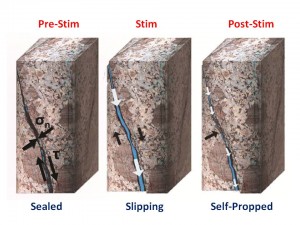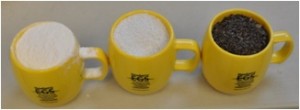
Thermally-degradable Zonal Isolation Materials (TZIMs)

Prior to stimulation, natural fractures in a geothermal well are tightly closed. Stimulation induces small amounts of slip along the fractures. The rough surface texture of fractures keeps them “self-propped”, or open to fluid flow after stimulation.
Thermally-degradable zonal isolation materials (TZIMs) are a family of biodegradable polymers used during EGS well stimulations. After a reservoir zone has been stimulated, TZIMs are pumped downhole. These biodegradable plastics temporarily block fractures intersecting the wellbore, allowing the next zone of fractures to open. Once several fracture zones have been created within a single reservoir, stimulation stops. The cold water pumped into the well during stimulation heats up, and the TZIMs biodegrade. Fractures are unblocked in the stimulated zones, and an interconnected network of permeable fluid flow zones develops. AltaRock’s TZIM technology makes multiple-zone geothermal reservoirs a reality.
Unlike other similar techniques, there are no residues or environmentally harmful byproducts resulting from TZIMs. Moreover, there is no need for gel breakers or acid washes to remove TZIMs from the wellbore after stimulation. Once the material is exposed to heat it biodegrades, leaving no residue or formation damage to the well.
Geothermal wells often achieve the depth and temperatures required for economic returns, but in many cases rock permeability may be less than ideal. AltaRock’s TZIM technology makes it possible to increase well value without the increased risk associated with drill rigs and mechanical packers. Well stimulation significantly improves permeability and fluid flow through a geothermal reservoir, enhancing overall heat transfer and production efficiency.

Thermally-degradable Zonal Isolation Material (TZIM) is a biodegradable plastic which decomposes to environmentally-friendly components as an EGS reservoir heats up after stimulation.
AltaRock holds patents for a suite of TZIMs to meet the stimulation requirements of specific well conditions, including rock type and temperature encountered. In order to plug or pack-off a range of fracture apertures, TZIMs are ground to various sizes. Degradation temperature is determined by polymer formula. For example, AltaVert 102 degrades 50% in a day at 190° F (88° C). Whereas AltaVert 156 degrades 50% in 1 day at 500° F (260° C), or in week at 430° F (220° C). The choice of diverter will depend on the injecting and static temperatures of the zone to be stimulated and the length of planned stimulation.

